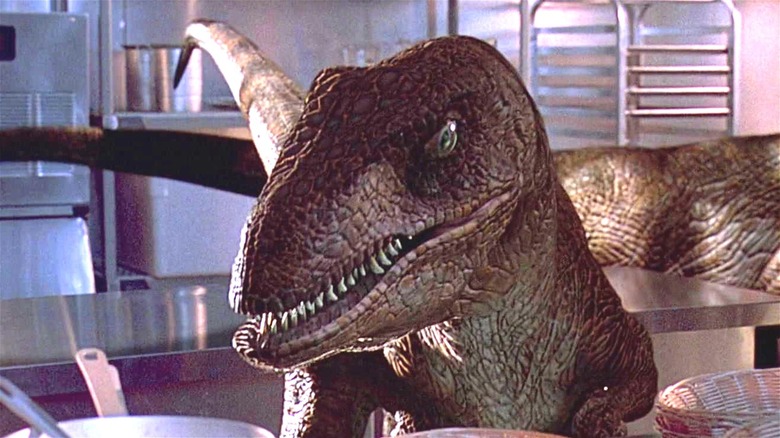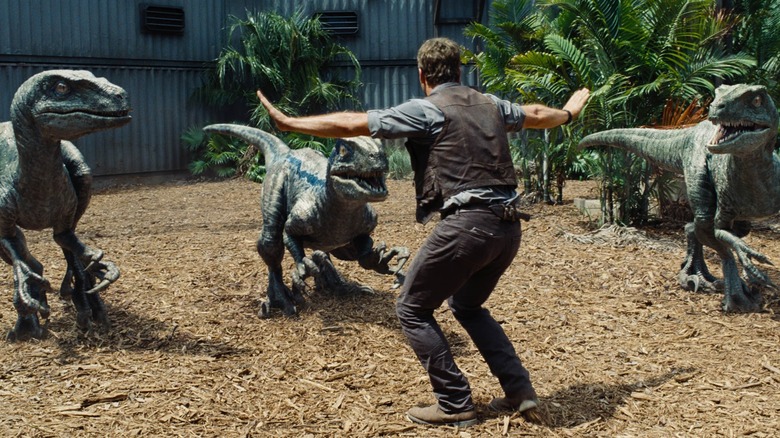The R-Rated Origins Of Jurassic Park's Velociraptor Roars
In 1993, the original "Jurassic Park" served as the coming out party for the Velociraptor. The adaptation of the 1990 Michael Crichton novel of the same name introduced most moviegoers to the terrifyingly swift and intelligent carnivores for the first time. While most people learn of some of the more traditional dinosaurs like Stegosaurus, Triceratops, Brontosaurus, and Tyrannosaurus Rex in the early years of education, the velociraptor was something new altogether for a lot of viewers.
In addition to a lesser-known species of dinosaur, "Jurassic Park" also introduced fans to completely new special effects technology, courtesy of the team at Industrial Light & Magic (ILM). The company, which had previously worked on sci-fi films like "Back to the Future Part III," "Terminator 2: Judgment Day," and "Star Trek VI: The Undiscovered Country," called the first entry in the "Jurassic Park" movie series "a milestone in modern visual effects" that opened the door to potential ideas and scripts that had previously been considered impossible to bring to fruition. "To create living, breathing, photorealistic dinosaurs the likes of which had never been seen before, the visual effects team developed a substantial amount of new technology." The film had such an impact that the Academy of Motion Picture Arts and Sciences released a retrospective 27 years later, detailing the special effects breakthroughs the film brought to bear.
"Jurassic Park" was nominated for three Oscars and captured all of them at the 66th annual Academy Awards in 1994, but it wasn't just the incredible CGI animation that stole the show. The film won for Best Visual Effects, Best Sound, and Best Sound Effects Editing, pulling off a major awards coup. Tying both of these seemingly disparate threads together, fans may be surprised to learn the origin of the Velociraptor sound effects. In fact, the sound designer who shared in the sound effects awards said the film would have been rated R if people knew where they came from!
Some of the raptor sound effects came from a tortoise mating
In 2013, sound designer Gary Rydstrom sat down for a phone interview with the folks at Vulture to talk about the "Jurassic Park" franchise. For the original movie, Rydstrom was tasked with essentially deciding what each dinosaur in the film would sound like, coming up with dozens of sound effects on his own. According to Vulture, he chose to spend months recording different animal species, some of an exotic nature, and then manipulate those recordings into something that was convincing enough to sound natural while still sounding like nothing human beings had heard before. If nothing else, he wouldn't have to face any kind of backlash; it's not like anyone could tell him what the dinos were really supposed to sound like!
As Rydstrom revealed to Vulture, the Velociraptors' own language for communicating with each other came from another reptile species, though they weren't coordinating an attack. "It's somewhat embarrassing, but when the raptors bark at each other to communicate, it's a tortoise having sex," Rydstrom said. "It's a mating tortoise!" He detailed that he recorded the sound effects at Marine World, though at first he said it sounded like a joke. "Tortoises mating can take a long time. You've got to have plenty of time to sit around and watch and record them.
Not all the Velociraptor effects came from animals getting down. Rydstrom said the breathing effects for the raptors when they're stalking the children in the kitchen came from a horse, an animal that was used for several of the dinosaurs. That hiss from when the stalking Velociraptor took out game warden Robert Muldoon (Bob Peck)? That was a goose. Clever girl!

